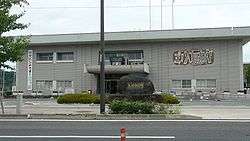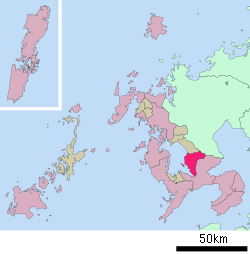Ōmura, Nagasaki
Ōmura (大村市, Ōmura-shi) is a city located in Nagasaki Prefecture, Japan.
Ōmura 大村市 | |
|---|---|
 Ōmura City Hall | |
 Flag Chapter | |
 Location of Ōmura in Nagasaki Prefecture | |
 Ōmura Location in Japan | |
| Coordinates: 32°54′0″N 129°57′30″E | |
| Country | Japan |
| Region | Kyushu |
| Prefecture | Nagasaki Prefecture |
| Government | |
| • Mayor | Hiroshi Sonoda |
| Area | |
| • Total | 126.34 km2 (48.78 sq mi) |
| Population (March 31, 2017) | |
| • Total | 95,146 |
| • Density | 750/km2 (2,000/sq mi) |
| Symbols | |
| • Tree | Quercus gilva |
| • Flower | Omura sakura |
| Time zone | UTC+9 (JST) |
| City hall address | 1-25 Kushima, Omura-shi, Nagasaki-ken 856-8686 |
| Website | www |
As of March 31, 2017, the city has an estimated population of 95,146[1] and a population density of 750 persons per km². Its total area is 126.33 km², and it includes Nagasaki Airport.
History
Ōmura is a castle town, and was the capital of Ōmura Domain, ruled by the local Ōmura clan for over 900 years in pre-Meiji Japan. It was the site of considerable foreign trade and missionary activity during the late Muromachi period, and the Catholic saint Marina de Omura hails from this city. Due to its proximity to the trading settlement at Dejima in Nagasaki, was one of the first areas of Japan to re-open to foreign contact after the end of the national seclusion policy after the Meiji Restoration. In the opera Madama Butterfly, set in nearby Nagasaki, the place name Omara in the line "ed alla damigella Butterfly del quartiere d'Omara Nagasaki" probably refers to Ōmura. From 1868-1945, Ōmura was host to numerous military facilities as part of the Sasebo Naval District, most notably that of a major air base for the Imperial Japanese Navy Air Service. The former naval base was the location of the squalid[2] Ōmura Migrant Detention Center, where mainly Korean refugees—termed "stowaways" (mikkōsha synonymous with "smuggler")—were held until deportation, frequently for several years. Since August 1996 the nearby Ōmura Immigration Reception Center in a modern building serves the same function.[3]
The modern city was founded on February 11, 1942. It was largely destroyed by American bombing on October 25, 1944. Its postwar recovery was assisted by the construction of Nagasaki airport offshore in Ōmura Bay, and by other public works projects.
Economy
Ōmura has a mixed economy, with the manufacture of refractory bricks as a major industry. Dairy and poultry farming, as well as cultured pearls are also of importance. However, due to its proximity to the larger urban centers of Nagasaki and Sasebo, Ōmura also serves as bedroom community for both cities.
Oriental Air Bridge, a regional airline, is headquartered in the city.[4] At one time J-Air had its headquarters at the airport.[5]
Sports
Ōmura hosted the official 2011 Asian Basketball Championship for Women.
Sister City relations




Friendly Cities

Notable people
- Hantaro Nagaoka, Meiji-era physicist
- Anza Ohyama, singer and stage actress
References
- "Official website of Ōmura City" (in Japanese). Japan: Ōmura City. Retrieved 26 April 2017.
- "East Asian version of the Nazi concentration camps ... We should not be misled by the facts that it has no gas chambers ..." Hayashi Kōzō, cit. in: Morris-Suzuki, Tessa; Borderline Japan: foreigners and frontier controls in the post-war era; Cambridge 2010; ISBN 978-0-521-86460-2, p. 167
- Morris-Suzuki, Tessa; Borderline Japan: foreigners and frontier controls in the post-war era; Cambridge 2010; ISBN 978-0-521-86460-2. Ch. 6
- "オリエンタルエアブリッジ株式会社." Oriental Air Bridge. Retrieved on May 20, 2009.
- "World Airline Directory." Flight International. March 19–25, 2002. 80.
- 大村市. "Sister Cities and a Friendly City". 大村市. Retrieved 2020-06-24.
External links
| Wikimedia Commons has media related to Omura, Nagasaki. |
- Ōmura City official website (in English)